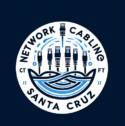Which Standard Is Most Commonly Used for Structured Cabling? A Complete Guide
If you’re planning a network setup for your home, office, or commercial building, understanding structured cabling standards is essential. Choosing the right standard ensures your network runs efficiently, stays reliable, and can grow with future technology.
In this guide, we’ll explain the most commonly used standards, why they matter, and how to implement them for optimal performance. Our team of structured cabling experts in Santa Cruz ensures every installation meets industry standards and delivers reliable network performance.
What Is Structured Cabling?
Structured cabling is a standardized system of cables, connectors, and hardware that forms the backbone of a data network. Unlike ad-hoc wiring, structured cabling is organized, scalable, and designed to support multiple types of communications, including data, voice, video, and security systems.
A proper structured cabling system:
- Reduces network downtime
- Supports high-speed connections
- Simplifies maintenance and troubleshooting
- Meets safety and compliance standards
The Most Common Standard: ANSI/TIA-568
When it comes to structured cabling, the ANSI/TIA-568 series is the most widely used standard in the United States, including homes and businesses in California.
Key Features of ANSI/TIA-568:
- Defines cable categories (Cat5e, Cat6, Cat6a, Cat7)
- Sets performance specifications for data transmission
- Provides pinout configurations for terminating cables
- Ensures compatibility between devices and systems
The ANSI/TIA-568 standard ensures your network supports reliable speeds and reduces interference, making it the go-to choice for structured cabling projects.
Other Important Standards
While ANSI/TIA-568 is the primary standard, there are other complementary standards you should know:
- ANSI/TIA-569: Standards for pathways and spaces used in cabling systems
- ANSI/TIA-606: Guidelines for labeling and documenting cabling systems
- ANSI/TIA-607: Grounding and bonding requirements
- ISO/IEC 11801: International structured cabling standard
These standards work together to ensure your cabling system is safe, organized, and scalable.
Why Following Standards Matters
Using a standardized approach for structured cabling offers many benefits:
- Reliability: Fewer errors and less downtime
- Scalability: Easier to upgrade to new technologies
- Compliance: Meets building codes and industry regulations
- Performance: Supports high-speed data transfer with minimal interference
Real-World Applications
Structured cabling following ANSI/TIA-568 standards is used across multiple sectors:
- Corporate offices: Reliable connections for VoIP, cloud applications, and video conferencing
- Educational institutions: Stable networks for computer labs, smart classrooms, and Wi-Fi access
- Healthcare facilities: Secure data transfer for patient records and monitoring equipment
- Retail and hospitality: Smooth operation of POS systems, surveillance cameras, and guest Wi-Fi
Choosing the Right Installer
Professional installation is key to ensuring your structured cabling meets standards. Certified installers:
- Understand ANSI/TIA-568 and related standards
- Follow local building codes
- Test and certify each connection
- Provide documentation for future maintenance
Hiring a licensed and experienced contractor ensures your network is reliable, compliant, and ready for growth. To understand how these guidelines are classified, check out our detailed overview of network cabling standards and their specific applications.
Conclusion
For anyone setting up a network, the ANSI/TIA-568 standard is the most commonly used and trusted approach for structured cabling in the U.S. Following this standard guarantees consistent performance, easy scalability, and long-term reliability.
Whether you’re upgrading an office, a commercial building, or a home network, working with a professional installer ensures your cabling is organized, tested, and compliant with industry standards.
